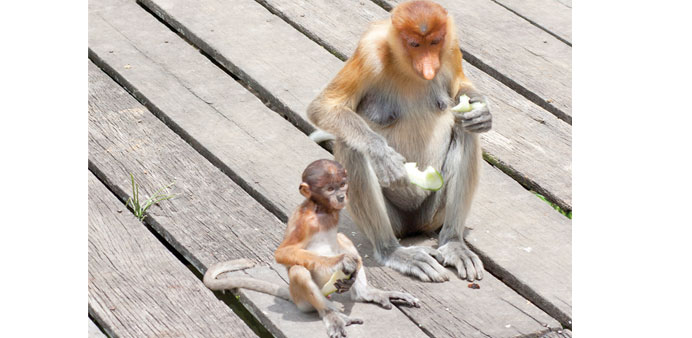The decline in the natural habitats of primates is because of habitat fragmentation and forest degradation where people are using trees for firewood, John Grafilo learns
Sen’s left paw clung combatively to the wooden railing, as his other paw was tugged by forest ranger Silik.
A six-year-old male orangutan, Sen stared at the big ranger, as if sizing him up. But Silik neither let go nor eased his pull on the primate, which wanted to tarry on the platform among a dozen tourists.
Apparently realising he was no match for Silik’s determination, Sen let go his grip on the railing and reluctantly followed the ranger into the trees, away from the tourists visiting the Sepilok Orangutan Rehabilitation Centre on the outskirts of Sandakan in Malaysia’s eastern state of Sabah.
“As much as possible, we minimise interaction between the orangutans and the tourists,” said Silik, who has been a forest ranger for over two decades. “We don’t want them to develop dependence on humans. We want them to survive on their own in the jungles.” But in another tug of war, between development and conservation of the forests — the primary habitats of at least 10 species of primates in Sabah — the outcome does not look beneficial to the animals.
The odds are against environmental preservation.
Conservationists underscore the need to find a better balance between conservation and development.
Except for the two macaque species in Sabah, eight other primate species — including the orangutans, gibbons and proboscis monkeys — are on the decline, according to conservationist Marc Ancrenaz.
Ancrenaz, a Frenchman who is the co-director of the Kinabatangan Orangutan Conservation Project, said there are only an estimated 11,000 orangutans currently living in Sabah and another 3,000 in the nearby Indonesian state of Sarawak.
He attributed the decline to a loss of the primates’ natural habitats: “It’s mostly because of forest destruction and conversion to agriculture. It’s because of habitat fragmentation, forest degradation when people are using trees for firewood.”
Ancrenaz added that human-against-primate conflicts have also been a contributory factor in the dwindling number of orangutans. Their name is from a Malay word that means “man of the forest,” but the cousins tend to get on badly with one another.
“In some places people are hunting down and killing orangutans which have raided their farms for food,” he said.
In a worse situation than the orangutans is the weird-looking proboscis monkey with its bulbous nose. Only an estimated 6,000 proboscis monkeys remain, Ancrenaz said.
Proboscis monkeys, which are endemic to the island of Borneo, live in coastal mangroves and riparian and swamp forests. They usually travel inland to forage and return to their sleeping sites along a river edge every evening.
Unfortunately, these habitats have been extensively logged and converted to permanent agriculture.
“The local extinction of proboscis monkey populations as a result of habitat loss has been recorded in Papar and in Kunak,” according to a joint study conducted in 2008 by John Sha, Henry Bernard and Senthival Nathan.
“This is likely to be only the tip of the iceberg with many other populations disappearing unrecorded,” they noted.
The government of Sabah has been expanding its protected forest reserves over the past decade in a bid to protect the Bornean wild, but degradation of forest lands continues.
“In developing countries, many protected areas — nature reserves and declared national parks — are only ‘paper parks.’ Their protected status, in reality, is not enforced nor are these areas effectively policed,” according to a study by Clem Tisdell and Hemanath Swarna Nantha for Australia’s University of Queensland.
“Protected areas have been established in Borneo that favour proboscis monkeys and orangutans, but these are often too small, fragmented or degraded to ensure ecologically the survival of the species, particularly in the case of the orangutan,” they added.
For Ancrenaz, the key to conservation of the orangutans and the proboscis monkeys is for people in some communities, especially those on the edge of the forests or in palm oil plantations, to learn to cohabit with the primates.
“Primates, they don’t stay only in protected forest. Sometimes they go out and they are living in places where people are also living, like in plantations or in the edge of the forests where people farm,” he said.
“We have to find ways for people and primates to cohabit together, this means doing a lot of education, awareness in the local communities to make sure that they learn to understand how these primates behave,” he added.
An example of successful cohabitation between human and primate is the privately run Labuk Bay Proboscis Monkey Sanctuary in Sandakan.
The 400-acre mangrove forest provides sanctuary for dozens of these bulbous-nosed primates. The land was spared from being converted into a palm-oil plantation by its Chinese-Malay owner, who is known only as Mr Lim.
The sanctuary was actually the last portion of more than a thousand acres of mangrove and flat land forests that had not yet been converted into Lim’s palm oil plantations.
“While the workers were preparing to clear the mangroves, Mr Lim saw these monkeys and was instantly fascinated,” an employee of the sanctuary said. “He decided not to push through with the plan to clear the area and instead instructed the workers to feed fruit to the monkeys, which were already starving because of lack of food.”
Tourists who visited were pleased at the experience of meeting proboscis monkeys up close, despite the steep price charged.
Leda, an Australian tourist from Adelaide, gawked at the sight of two male proboscis monkeys fighting to woo a female.
“Oh, they would really fight for the one they love,” she said.
Ancrenaz said eco-tourism is one of the best models to keep primates and humans living together peacefully.
“In places where you have primates like proboscis monkeys and orangutans, tourists are coming. By welcoming tourists the local community makes more money, so it’s certainly possible for people and primates to live together, and it’s a way to build up the economy of the local community,” he said.
“It’s all about balancing the need for development and the need for conservation,” he added. “This balance is sometimes difficult to find, but it can be achieved.” — DPA



